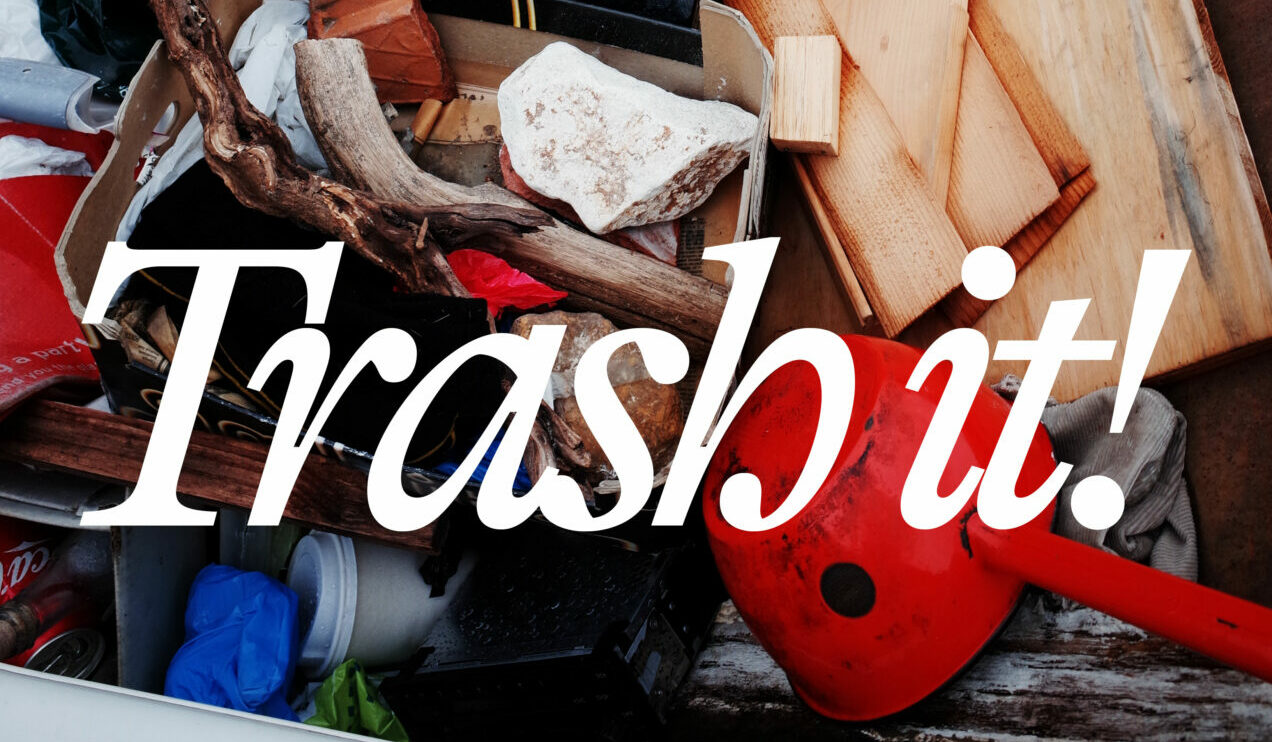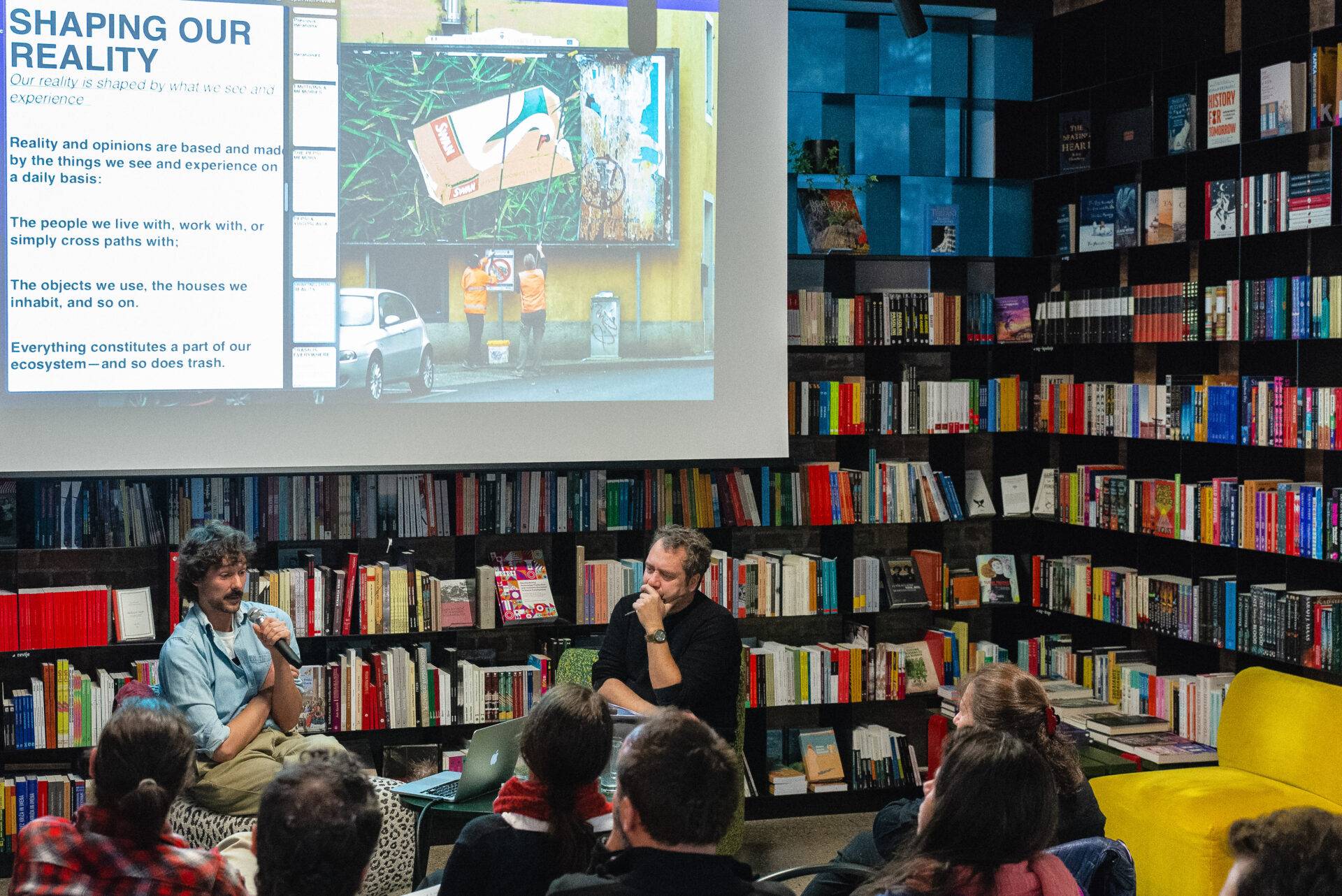Highlights
Photos by Erin McKinney & Enrico Policardo
Audio conferenza Pogačar + Policardo
(recorded by Tonino Vantaggiato)
The event is organised in collaboration with ZRC SAZU and the University of Nova Gorica and tackles the provocative yet often overlooked issue of waste. Inspired by the theme already introduced with the city-wide exhibition Branded Trash, this discussion aims to confront the public with the topic of human produced trash, exploring in an unconventional and thought-provoking manner our often uncomfortable relationship with waste. Participants will be challenged to reconsider how memory, personal history, and unconscious habits influence our everyday choices. The event will consist of three parts: a small talk by Martin Pogačar, a brief introduction to the Branded Trash exhibition by Enrico Policardo, which will serve as the the opeining of the exhibition itself and an interactive workshop by Peter Purg
Event Program
15:00 – 16:00
Trash it! Bin it! Dump it? Waste as a Mnemonic Agent
A reflection on waste and memory by Martin Pogačar, associate researcher at the ZRC SAZU Institute in Ljubljana.
All life produces waste. In many cases, this waste is organic and compostable, supporting the metabolic cycle of life. However, following the Industrial Revolution, the rise of petrochemicals and other inorganic materials has gradually intertwined with human existence, moving us away from the organic and into a hybrid world of inanimate substances. Unlike organic waste, inorganic waste does not support the metabolic cycle; instead, it contributes to its disintegration. In particular, inorganic carbon-based materials (petrochemicals) present an invasive presence that is difficult and slow to degrade, constantly surrounding us. Or rather, we are bombarded with new items that quickly become rubbish (new! now!). Over time, this waste has become increasingly invisible.
Today, waste is omnipresent and poses an existential problem that will require creativity, expertise, and energy to address. However, the issue of garbage can also be approached artistically and through research, prompting us to ask important questions:
What is garbage? What is it made of? Where is it found? How long does it last? What defines something as rubbish? How do we relate to it? What distinguishes waste from non-waste? What can we learn from it? What does it reveal about daily life in the past, including previous production and consumption practices? How does it relate to memory and the future?
In this presentation, we will address these questions, particularly focusing on the mnemonic aspects of waste: What emotions does it evoke? What effects does it have? How is the materiality of our world connected to memory through waste?
BRANDED TRASH
A project about waste and visual Communication – A Project by Enrico Policardo, Photographer
There is something fascinating about garbage: it always attracts attention.
I think of an old sun-bleached Pepsi can, abandoned for years next to a bunch of thriving mushrooms, growing peacefully in the woods near my hometown, a few miles from the border.
This is my first memory of waste being discarded by humans.
The faded blue and Pepsi logo, not Coca Cola, because Yugoslavia was a communist country and Coca Cola was too American to be allowed.
Or at least that’s what I thought – I didn’t know it had actually been sold there since the 1960s, apparently. But I have no memory of it, at least not before 1990.
Then things changed. Coca Cola cans began to appear regularly, even in the woods.
Signs of the times. Joining the West.
I preferred Pepsi, especially the Yugoslavian one. And obviously there was, and still is, the Cockta: which I would define as the Marmite of the Balkans, not for its flavour, but for the love/hate relationship it provokes. But this series isn’t about Yugo-Nostalgia or Eastern European sodas. It’s about waste, brands and how much humanity is reflected in the rubbish it generates. Now there is no more Pepsi in the woods. But there are plenty of Coca Cola cans, iPhone cables, Mondelez products, Heineken beers – not just in the woods near my house, but all over the world.
Branded garbage is not just ordinary garbage. It’s not just an environmental disaster.
It’s also advertising; Unpaid advertising for brands: insidious and ubiquitous. It captures our busy eyes and minds; endless product placement in the movies of our lives.
It doesn’t matter where I am now or what my tastes are. Pepsi will always have the power of nostalgia.
16:00 – 17:30
Workshop: Trashing It Together
A workshop by Peter Purg.
Bring a piece of trash.
It can be yours or someone else’s—borrowed or even stolen.
It can be a physical object, a photo or video, or a story or anecdote about a piece of rubbish.
Together we will discuss:
- What is it made of?
- What could it become?
- Who discarded it and why?
- What does it have in common with the other waste present?
Together, we will imagine how this object can transform into something new—a sculpture, a performance, an event, an exhibition, an app, a product, a smoothie, or even a dish that could be created from that piece of rubbish.













